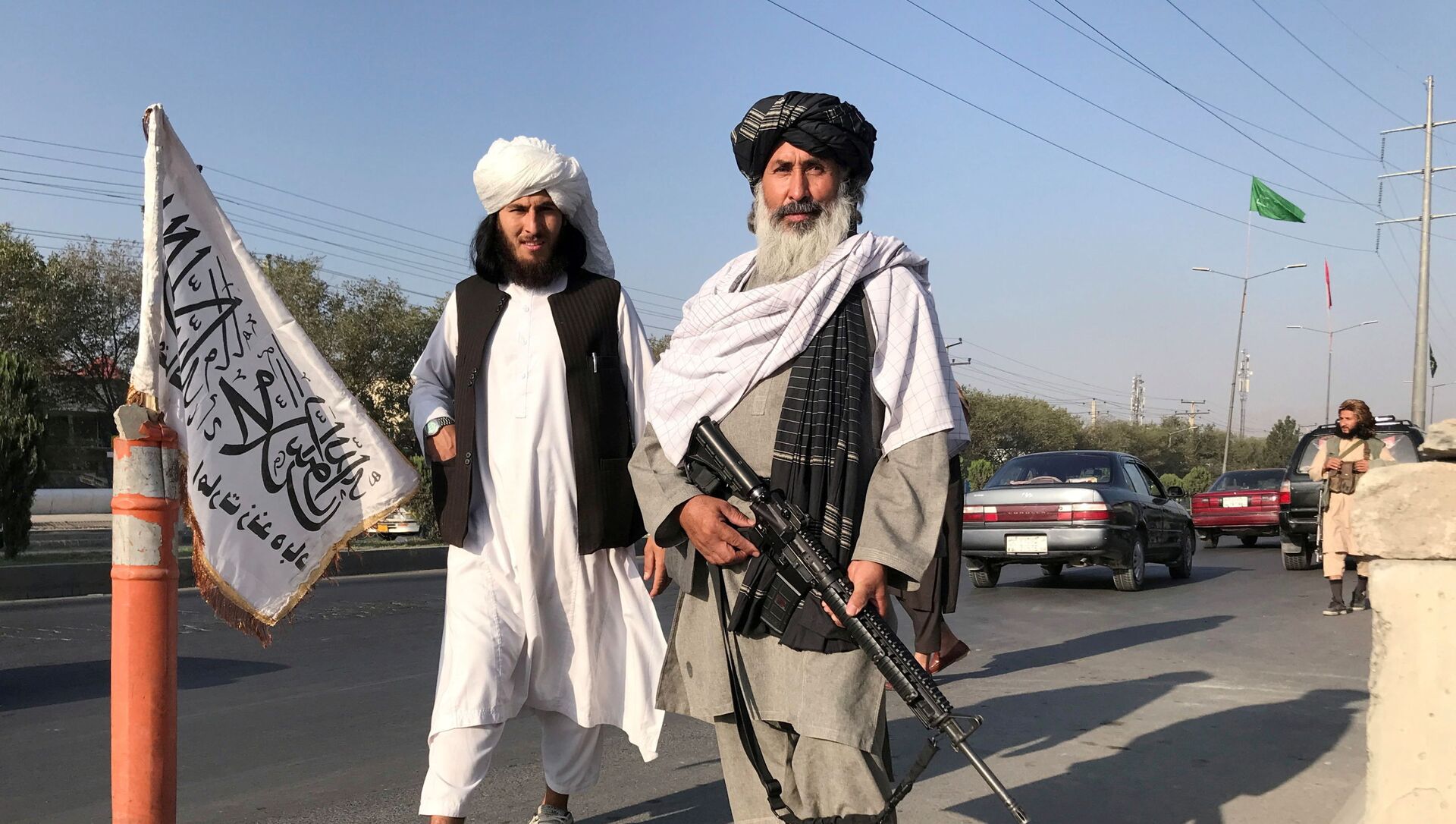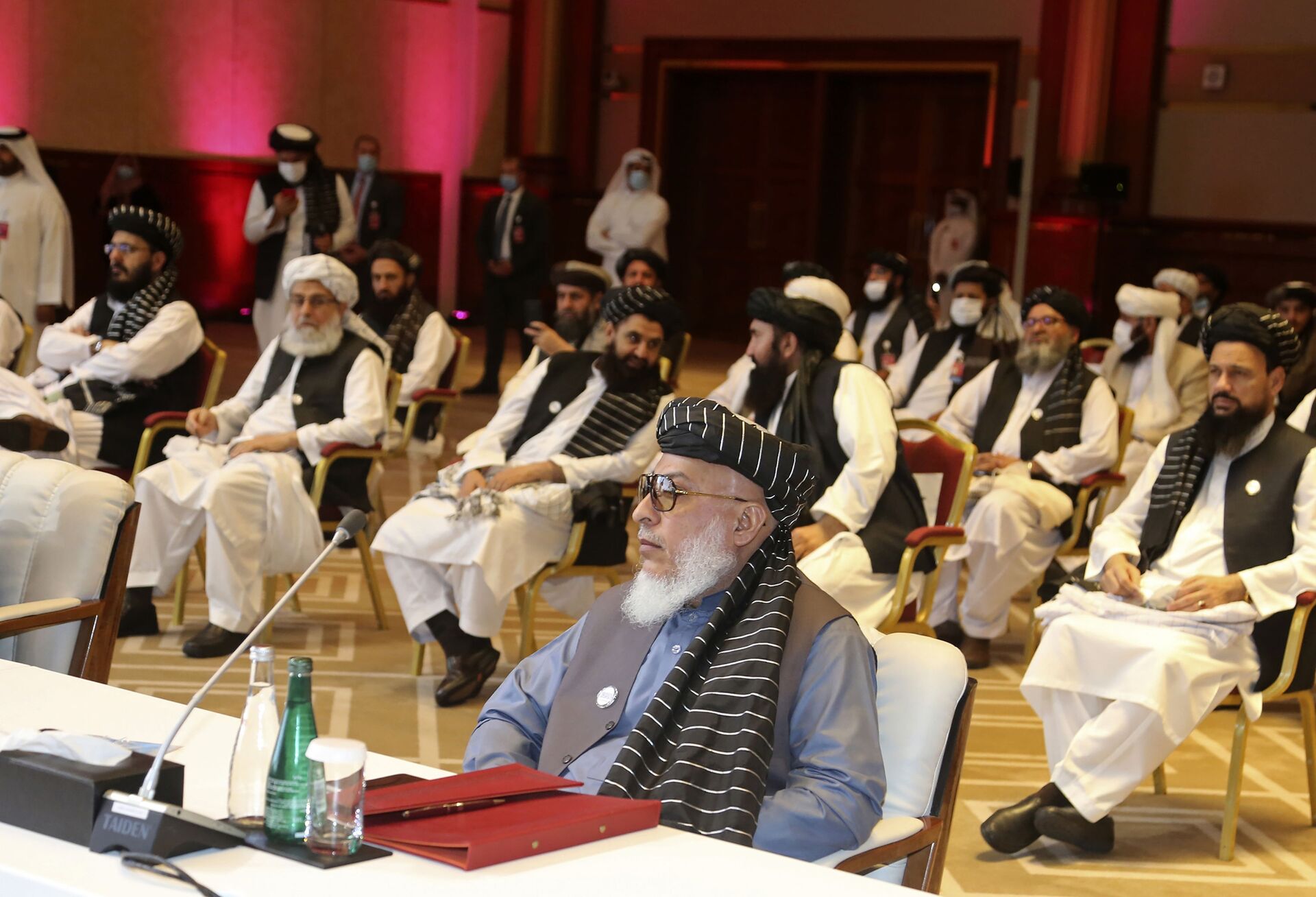Will US-Made Arms be Kept by the Taliban or Make Their Way to Bazaars, Daesh & Al-Qaeda Terrorists?
11:01 GMT 21.08.2021 (Updated: 13:22 GMT 06.08.2022)

© REUTERS / STRINGER
Subscribe
The Taliban* has laid its hands on huge stockpiles of US-made arms, prompting fears that Afghanistan would now turn into a hornet's nest should these weapons start circulating among various jihadi and terrorist actors on the ground. What measures could be taken to prevent the proliferation of sophisticated arms?
While it is not clear exactly how many weapons have fallen into the hands of the Afghan insurgents, the current intelligence assessment is that the Taliban's war chest now includes at least 2,000 armored vehicles, up to 40 aircraft, supposedly including UH-60 Black Hawks, ScanEagle military drones, scout attack helicopters, thousands of rifles, and potentially, night-vision goggles, according to Reuters.
Social media platforms are awash with images and videos allegedly showing the Afghan militants holding US-made M4 carbines, standing near Humvees, and even flying in choppers. All in all, Washington has spent an estimated $83 billion on training and equipping Afghan government forces, according to The Hill. Of this sum, the US gave Kabul approximately $28 billion in weaponry between 2002 and 2017. Everything that has not been destroyed is believed to have fallen into the Taliban's hands.
US Weapons in the Hands of Terrorists
On 18 August, a group of 25 Republican Senators sent a letter to US Secretary of Defense Lloyd Austin requesting a full account of US military equipment left behind in Afghanistan, after National Security Adviser Jake Sullivan admitted a day earlier that the Taliban had grabbed "a fair amount" of weapons. American law-makers have expressed fears that the US-made arms could now be used for quashing resistance and even end up in the hands of al-Qaeda* and Daesh (ISIS/ISIL)*.
"We need to keep in mind that the weaponry of a whole military of three hundred thousand troops is seized by the Taliban, which is scattered all over the country," says Abdullah Khan, director of Pakistan Institute for Conflict and Security Studies. "It is a strong possibility that a handful of these weapons fell into the hands of terrorist organisations like ISIS and others."
Furthermore, American military gear is already easily available at black markets and bazaars in Pakistan and Afghanistan, Khan notes. Still, he believes that the Taliban will make efforts to collect these weapons and keep them for themselves.
A nice collection of Humvees, seized by the Taliban from the Afghan army, in Kabul today. pic.twitter.com/gjkus9DgOs
— WorldOnAlert (@worldonalert) August 20, 2021
Fakhar Kakakhel, an independent analyst specialising in militancy in Afghanistan and Pakistan, shares this stance: according to him, the Afghan militant group has already started the collection and documentation of the arms seized. When it comes to weaponry finding its way to local bazaars, he suggests that these are "individual instances" and by no means "a collective policy."
Not sure whose garden these TB fellas are hanging out at. But appears to be in Kabul. #Afghanistan pic.twitter.com/w9QsxakQs2
— FJ (@Natsecjeff) August 21, 2021
The situation is complicated by the fact that a lot of terrorists from the region who were incarcerated in Kabul and in prisons were released by the Taliban, according to Weeda Mehran, a lecturer on conflict, security and development at Britain's University of Exeter.
The Taliban has seized AAF's UH-60 Black Hawk & Mil Mi-8/17 helicopters at the Kandahar Airport. pic.twitter.com/GGjKAzoNzH
— Status-6 (@Archer83Able) August 14, 2021
On 15 August, Axios reported that the 5,000 to 7,000 inmates of Pul-e-Charkhi prison, located east of Kabul, including al Qaeda and Taliban operatives, had all been set free by the Taliban forces. Some of these former prisoners were also from local terrorist organisations such as Tehrik-i- Taliban* of Pakistan (TTP), remarks Mehran.
"If the Taliban does not take stock of those weapons or protect them or even itself just uses them or hands them over or lets other organisations take hold of them, that can be quite problematic," she warns.

In this Sept. 12, 2020, file photo, Taliban negotiator Abbas Stanikzai, center front, and his delegation attend the opening session of peace talks between the Afghan government and the Taliban, in Doha, Qatar. Afghanistan’s Taliban on Thursday, Oct. 8, 2020, welcomed a tweet from President Donald Trump in which he promised to have the last of the U.S.'s troops out of Afghanistan by Christmas. If that withdrawal happens, it would be months ahead of schedule and the tweet made no reference to a Taliban promise to fight terrorist groups — a previous pre-requisite for an American withdrawal.
© AP Photo / Hussein Sayed
Silver Lining: Taliban Seeking International Recognition
One might wonder as to what are the odds of the Taliban preventing arms proliferation. In fact, the Afghan insurgents are directly interested in shielding in the country from foreign terrorist entities as the Taliban is striving for international recognition, notes Dr Michele Groppi, a teaching fellow from the Challenges to the International Order in the Defence Studies Department, King's College London.
"The United States didn't leave just as desperately as some people would say, no, they didn't," argues Groppi. "There are agreements in place with the Taliban. Take, for instance, the Doha talks in Qatar. The agreement or part of the agreement is that the Taliban are not going to harbour any terrorist organisation. So the Haqqani network, which is a Taliban splinter cell, doesn't have to act in a belligerent way. Daesh, al-Qaeda itself, in theory, at least on paper are not welcome."
The Taliban's cooperation with Daesh, al-Qaeda or other terrorist groups could spell the end to their plan to create a new state, Groppi believes. He does not rule out that the Afghan insurgents could actually use the newly-obtained weapons to fight against Daesh. "Let's remember: ISIS, the Taliban, and al-Qaeda don't like each other," he says.
A month ago nobody would have believed that these guys are Taliban fighters. pic.twitter.com/1ZNGk7t9MW
— WorldOnAlert (@worldonalert) August 20, 2021
"I'm pretty sure that the United States and even, according to my sources on the field, even members of the former Afghan forces, are convinced that the Taliban are using those weapons and they're using them against Daesh in the first place," he presumes.
NOW - Taliban "special forces" parade with U.S.-made weapons in Zabul Province, southeast #Afghanistan. pic.twitter.com/hRXnnBpKGT
— Disclose.tv (@disclosetv) August 20, 2021
Meanwhile, it's similarly important to make sure that the Taliban would not use these weapons against Afghan civilians and opposition groups, the observer points out.
How Could the US Disarm the Taliban?
While the US government is trying to take inventory of all of the equipment left, Joe Biden is reportedly mulling airstrikes to destroy the surrendered weapons. To date, this plan has allegedly been refuted because of fears it will antagonise the Taliban while people are still being evacuated from the country, according to Reuters.
"I’m not sure, but this will escalate the war again," warns Fakhar Kakakhel. "The US will bomb and will create more extremists in the name of collateral damage. I’m not sure whether the US will do that or not, but if they do, this will not only limit the weapons but will create another faction of extremists and give birth to another war."
According to Kakahel, this embarrassing situation would have never occurred if the US had taken responsibility and prevented the Afghan military stockpiles from being looted. He argues that it was up to Washington to stay for the settlement and disarm both warring parties.
"Now the only option left is the collective efforts by neighbouring countries," he presumes. "There must be a joint forum to devise a strategy for post-withdrawal Afghanistan, with a primary focus on a de-weaponised Afghanistan."
There should be international pressure on the Taliban, and particularly from the US side, echoes Weeda Mehran.
Under these circumstances it is crucial for the Taliban to form a legitimate government as soon as possible to avoid the use of force by external actors and to settle the matter through negotiations, believes Abdullah Khan. "The new Afghan government will be the legitimate owner of this military equipment," he notes.
*The Taliban, TTP, al-Qaeda, and Daesh (ISIS/ISIL/Islamic State) are terrorist organisations banned in Russia and many other countries.

